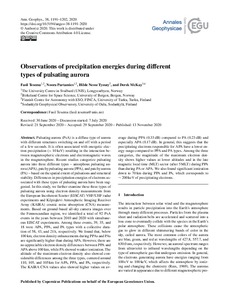Observations of precipitation energies during different types of pulsating aurora
Fasil Tesema; Noora Partamies; Hilde Nesse Tyssøy; Derek McKay
https://urn.fi/URN:NBN:fi-fe2021042824695
Tiivistelmä
Pulsating aurora (PsA) is a diffuse type of aurora with different
structures switching on and off with a period of a few seconds. It is
often associated with energetic electron precipitation (>10 keV)
resulting in the interaction between magnetospheric electrons and
electromagnetic waves in the magnetosphere. Recent studies categorize
pulsating aurora into three different types – amorphous pulsating aurora
(APA), patchy pulsating aurora (PPA), and patchy aurora (PA) – based on
the spatial extent of pulsations and structural stability. Differences
in precipitation energies of electrons associated with these types of
pulsating aurora have been suggested. In this study, we further examine
these three types of pulsating aurora using electron density
measurements from the European Incoherent Scatter (EISCAT) VHF/UHF radar
experiments and Kilpisjärvi Atmospheric Imaging Receiver Array (KAIRA)
cosmic noise absorption (CNA) measurements. Based on ground-based
all-sky camera images over the Fennoscandian region, we identified a
total of 92 PsA events in the years between 2010 and 2020 with
simultaneous EISCAT experiments. Among these events, 39, 35, and 18 were
APA, PPA, and PA types with a collective duration of 58, 43, and 21 h,
respectively. We found that, below 100 km, electron density enhancements
during PPAs and PAs are significantly higher than during APA. However,
there are no appreciable electron density differences between PPA and
APA above 100 km, while PA showed weaker ionization. The altitude of the
maximum electron density also showed considerable differences among the
three types, centered around 110, 105, and 105 km for APA, PPA, and PA,
respectively. The KAIRA CNA values also showed higher values on average
during PPA (0.33 dB) compared to PA (0.23 dB) and especially APA
(0.17 dB). In general, this suggests that the precipitating electrons
responsible for APA have a lower energy range compared to PPA and PA
types. Among the three categories, the magnitude of the maximum electron
density shows higher values at lower altitudes and in the late magnetic
local time (MLT) sector (after 5 MLT) during PPA than during PA or APA.
We also found significant ionization down to 70 km during PPA and PA,
which corresponds to ∼200 keV of precipitating electrons.
Kokoelmat
- Rinnakkaistallenteet [27094]
